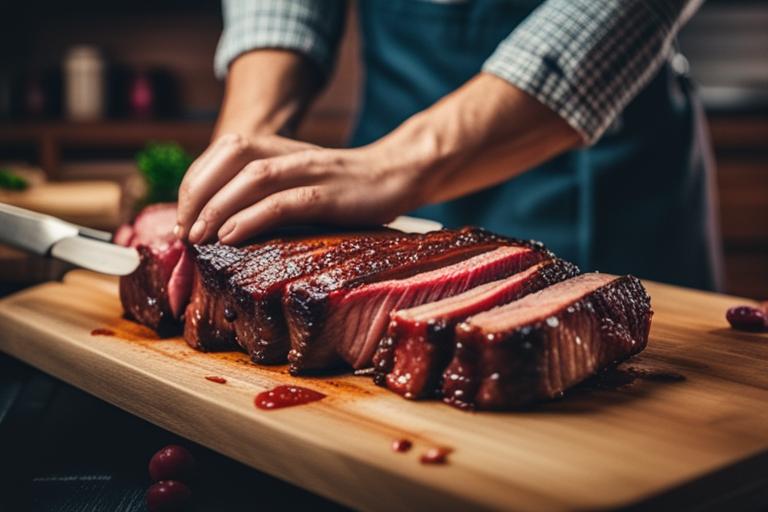Are you wondering how to clean ribs properly before cooking them? Look no further! In this ultimate guide, we’ll cover everything you need to know about how to clean ribs, including different cleaning methods, how to prepare the ribs for cleaning, and tips for seasoning and cooking the meat to perfection.
How to Clean Ribs: Tips and Tricks
By reading this article, you will learn:
– Why it is important to clean ribs before cooking
– Different methods for cleaning ribs
– Tips for seasoning and cooking the ribs perfectly
Ribs are a popular meat dish enjoyed worldwide. However, to enjoy juicy, flavorful ribs, it’s important to properly clean and prepare them before cooking. Properly cleaning the ribs not only removes bacteria or harmful substances but also improves the flavor and texture of the meat. Additionally, properly seasoning and cooking the ribs can make all the difference in the final result.
Why Clean Your Ribs?
Before we dive into the cleaning process, let’s first discuss why it’s important to clean your ribs. One of the main reasons is to reduce the risk of foodborne illness. Raw meat can contain harmful bacteria such as E. coli or salmonella, and cleaning the meat can help to eliminate these risks. Additionally, cleaning the ribs can improve the flavor and texture by removing any unwanted debris, such as bone fragments or excess fat. Finally, properly cleaned ribs will allow for better adherence of seasoning and rubs, resulting in a more flavorful and delicious meal.

Preparing the Ribs
Before you can start cleaning the ribs, you’ll need to properly prepare them. This involves trimming any excess fat or loose meat, as well as rinsing the ribs under cold water. To trim the ribs, use a sharp knife to remove any excess fat or unwanted pieces of meat. Next, rinse the ribs under cold water to remove any debris or impurities. Finally, pat the ribs dry with a paper towel to prepare them for the cleaning process.

Cleaning Methods
There are several different methods for cleaning ribs, including boiling, scrubbing, and soaking. Each method has its own benefits and drawbacks, so it’s important to choose the method that works best for your needs.
Boiling Method
The boiling method involves simmering the ribs in a pot of water for a set amount of time. This method is effective at removing any impurities or bacteria and can also help to tenderize the meat. However, boiling the ribs can also cause the meat to become dry and tough if not done properly.
To boil the ribs, place them in a large pot of water and bring the water to a boil. Reduce the heat to a simmer and let the ribs cook for approximately 30 minutes. Once done, remove the ribs from the pot and pat them dry before seasoning and cooking.
Scrubbing Method
The scrubbing method involves manually scrubbing the ribs with a brush or sponge to remove any debris or bacteria. This method can be time-consuming and labor-intensive, but it’s effective at removing any unwanted substances from the meat.
To scrub the ribs, use a brush or sponge to manually scrub the meat under cold water. Be sure to scrub all sides of the ribs thoroughly, including any crevices or hard-to-reach areas. Once done, pat the ribs dry before seasoning and cooking.
Soaking Method
The soaking method involves soaking the ribs in a mixture of water and vinegar or lemon juice for a set amount of time. This method helps to remove any impurities or bacteria, while also tenderizing the meat. However, soaking the ribs for too long can cause the meat to become mushy and flavorless.
To soak the ribs, mix together equal parts water and vinegar or lemon juice in a large bowl. Place the ribs in the bowl and let them soak for approximately 30 minutes. Once done, remove the ribs from the bowl and pat them dry before seasoning and cooking.
Cleaning the Ribs
Regardless of the method you choose, it’s important to remove any excess fat or membrane from the meat before cleaning. This will help to ensure that the ribs cook evenly and don’t become too greasy.
To clean the ribs, follow the steps for your chosen cleaning method as outlined above. Be sure to thoroughly clean all sides of the ribs, including any crevices or hard-to-reach areas. Once done, pat the ribs dry with a paper towel before seasoning and cooking.
Drying the Ribs
Before seasoning the ribs, it’s important to dry them thoroughly to ensure that the seasoning adheres properly. To do this, pat the ribs dry with a paper towel or let them air-dry for a few minutes. Avoid using a hairdryer or other heating device, as this can cause the meat to become too dry and tough.
Seasoning the Ribs
Seasoning the ribs is an important step in the cooking process, as it helps to enhance the flavor of the meat. There are many different seasoning options and combinations to choose from, including dry rubs, marinades, and sauces.
To season the ribs, apply the seasoning or rub evenly to all sides of the meat. Be sure to use enough seasoning to fully cover the meat, but don’t overdo it. Once seasoned, let the ribs sit for a few minutes to allow the flavors to fully develop.

Cooking the Ribs
Once the ribs are cleaned, dried, and seasoned, it’s time to cook them. There are many different cooking methods to choose from, including grilling, smoking, and baking. Regardless of the method you choose, it’s important to monitor the cooking process to ensure that the meat doesn’t become overcooked or burnt.
To cook the ribs, follow the steps for your chosen cooking method as outlined in a recipe or other guide. Be sure to monitor the temperature of the meat to ensure that it’s cooked to your desired level of doneness. For example, for pork ribs, the USDA recommends cooking to an internal temperature of 145°F.
Pros and Cons of Cleaning Methods
| Cleaning Method | Pros | Cons |
|---|---|---|
| Boiling | Effective at removing impurities and tenderizing meat | Can cause meat to become dry and tough |
| Scrubbing | Effective at removing debris and bacteria | Time-consuming and labor-intensive |
| Soaking | Removes impurities and tenderizes meat | Can cause meat to become mushy and flavorless if soaked for too long |
| Cleaning Method | Pros | Cons |
|---|---|---|
| Boiling | Effective at removing impurities and tenderizing meat | Can cause meat to become dry and tough |
| Scrubbing | Effective at removing debris and bacteria | Time-consuming and labor-intensive |
| Soaking | Removes impurities and tenderizes meat | Can cause meat to become mushy and flavorless if soaked for too long |
Personal Story: The Importance of Properly Cleaning Ribs
Growing up in the South, my family had a tradition of having a big barbecue every summer. I always looked forward to it because the ribs were always the highlight of the meal. However, one summer, my uncle got very sick after eating the ribs and had to be rushed to the hospital. It turned out that the ribs hadn’t been cleaned properly and had been contaminated with bacteria.
After that incident, my family started taking extra precautions when it came to cleaning and preparing the ribs. We made sure to trim off all excess fat and loose meat, and we always washed the ribs thoroughly before cleaning them. We also experimented with different cleaning methods, and found that boiling the ribs was the most effective for us.
Now, when I make ribs for my own family, I always make sure to follow these same steps to ensure that the meat is safe and delicious. It may take a little extra time and effort, but it’s worth it to avoid any potential health risks and to make the best tasting ribs possible.
Conclusion
Cleaning and prepping your ribs properly is an essential step in achieving a delicious and flavorful meal. By following the tips and tricks outlined in this guide, you can ensure that your ribs are properly cleaned, seasoned, and cooked to perfection. Remember to choose the cleaning and seasoning methods that work best for your needs, and don’t be afraid to experiment with different flavors and techniques. With a little practice and patience, you’ll be able to create mouth-watering ribs that are sure to impress your friends and family.
Follow us!!Insider Tip: When seasoning your ribs, be sure to use a high-quality rub or marinade that complements the flavors of the meat. Don’t be afraid to experiment with different combinations of spices and herbs to find the perfect flavor profile for your ribs.